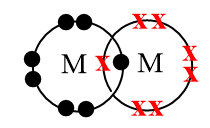
The electronic configuration of four elements are given in brackets $L\left( 1{{s}^{2}},2{{s}^{2}}2{{p}^{1}} \right)$; $M\left( 1{{s}^{2}},2{{s}^{2}}2{{p}^{5}} \right)$; $Q\left( 1{{s}^{2}},2{{s}^{2}}2{{p}^{6}},3{{s}^{1}} \right)$; $R\left( 1{{s}^{2}},2{{s}^{2}}2{{p}^{2}} \right)$. The element that would most readily form a diatomic molecule is:
A) $Q$
B) $M$
C) $R$
D) $L$
Answer
219.6k+ views
Hint: The elements with seven electrons in their valence shell (Group 17 elements) readily combine with the other element of the same group through a nonpolar covalent bond resulting in the formation of a diatomic molecule.
Complete step by step solution:As per the given electronic configuration in the question, the element which require only one electron to complete its octet is $M\left( 1{{s}^{2}},2{{s}^{2}}2{{p}^{5}} \right)$ which belongs to group 17 group i.e., it is a part of halogen family in which all the elements shows a tendency to readily share their electrons to form a nonpolar covalent bond and results in formation of diatomic molecule as shown in the figure below:

Also, diatomic molecules of alkali metals with electronic configuration $L\left( 1{{s}^{2}},2{{s}^{2}}2{{p}^{1}} \right)$ are detected in their gas phase but the bond between the elements is very weak because the outer orbitals of the alkali metals are very diffuse and thus, the possibility to exist as a diatomic molecule is very less. Due to this reason, the alkali metals mostly form ionic bonds with the elements.
Hence, the element that would most readily form a diatomic molecule is $M$.
Option ‘B’ is correct
Note: It is important to note that the only element in group 17 which does not exist as a diatomic molecule is Astatine because it is a short lived radioactive element which does not occur in nature. Thus, only fluorine, chlorine, bromine and iodine elements in group 17 exist as diatomic molecule.
Complete step by step solution:As per the given electronic configuration in the question, the element which require only one electron to complete its octet is $M\left( 1{{s}^{2}},2{{s}^{2}}2{{p}^{5}} \right)$ which belongs to group 17 group i.e., it is a part of halogen family in which all the elements shows a tendency to readily share their electrons to form a nonpolar covalent bond and results in formation of diatomic molecule as shown in the figure below:

Also, diatomic molecules of alkali metals with electronic configuration $L\left( 1{{s}^{2}},2{{s}^{2}}2{{p}^{1}} \right)$ are detected in their gas phase but the bond between the elements is very weak because the outer orbitals of the alkali metals are very diffuse and thus, the possibility to exist as a diatomic molecule is very less. Due to this reason, the alkali metals mostly form ionic bonds with the elements.
Hence, the element that would most readily form a diatomic molecule is $M$.
Option ‘B’ is correct
Note: It is important to note that the only element in group 17 which does not exist as a diatomic molecule is Astatine because it is a short lived radioactive element which does not occur in nature. Thus, only fluorine, chlorine, bromine and iodine elements in group 17 exist as diatomic molecule.
Recently Updated Pages
Chemical Equation - Important Concepts and Tips for JEE

JEE Main 2022 (July 29th Shift 1) Chemistry Question Paper with Answer Key

Conduction Explained: Definition, Examples & Science for Students

Analytical Method of Vector Addition Explained Simply

Atomic Size - Important Concepts and Tips for JEE

JEE Main 2022 (June 29th Shift 1) Maths Question Paper with Answer Key

Trending doubts
JEE Main 2026: Application Form Open, Exam Dates, Syllabus, Eligibility & Question Papers

Derivation of Equation of Trajectory Explained for Students

Hybridisation in Chemistry – Concept, Types & Applications

Understanding the Angle of Deviation in a Prism

Understanding Collisions: Types and Examples for Students

Understanding Atomic Structure for Beginners

Other Pages
NCERT Solutions For Class 11 Chemistry Chapter 7 Redox Reaction

JEE Advanced Marks vs Ranks 2025: Understanding Category-wise Qualifying Marks and Previous Year Cut-offs

Thermodynamics Class 11 Chemistry Chapter 5 CBSE Notes - 2025-26

NCERT Solutions ForClass 11 Chemistry Chapter Chapter 5 Thermodynamics

Equilibrium Class 11 Chemistry Chapter 6 CBSE Notes - 2025-26

Organic Chemistry Some Basic Principles And Techniques Class 11 Chemistry Chapter 8 CBSE Notes - 2025-26




